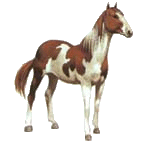|
|
American Paint Horse |
|
|
American Paint Horse |
 Paint horses have been favorites with horsemen since early man scratched its likeness on cave
walls. Egyptians left wall murals, paintings, mosaics and sculpture that shows the spotted horses. The Chinese represented them many times in the memorials that have been unearthed in burial mounds.
Paint horses have been favorites with horsemen since early man scratched its likeness on cave
walls. Egyptians left wall murals, paintings, mosaics and sculpture that shows the spotted horses. The Chinese represented them many times in the memorials that have been unearthed in burial mounds.
Paint horses can be traced not only in the art of ancient civilizations, but in the spotted Oriental horses brought from the plains of Eurasia by the Huns and various other tribes during the barbaric invasions of the Roman Empire around 500 A.D. The influence of these spotted horses on the Mediterranean countries can be best demonstrated in the area of Spain. Horsemen of the Spanish kingdoms began crossing the Oriental Paint horses with their native horses. By 700 A.D., many vari-colored horses carrying the Paint overo and tobiano patterns were already established, according to Glynn W. Haynes in his book "The American Paint Horse." The native Spanish horse that evolved from mixing the Northern Gothic type horse with the hotblooded Oriental horse became the Spanish Andalusian horse.
When the Moslems invaded Spain around 710 A.D., they brought the Barb horses from North Africa thought to be descended from the desert-bred Arabians.
During the Moslem domination from 710 A.D. to 1492, many Barbs were crossed on the Spanish horses, creating the Spanish Barb.
Haynes maintains that many of these Spanish-bred horses that left ports near the Spanish Cordoba Plains were Paint horses. Theses were the first Paints to come to America and their ancestors remain with us today.
The descendants of these first American Paint horses became the prized Indian War horses, the Spanish cow pony, and the Western stock horse of the 18th and 19th centuries. Then in this century the Paint Horse received a liberal amount of Quarter Horse and Thoroughbred blood, resulting in the modern Paint Horse with his varied ability to run, show or work cattle.
 Paints are a color breed based upon and regulated by restricted bloodlines. The Association does
not recognize outcrosses with gaited, pony or draft horse breeds. Outcrosses are permitted, but
are limited to Quarter Horses and Thoroughbred breeds. Its breeding is based upon the
bloodlines of horses registered in the American Paint Horse Association (APHA), the American
Quarter Horse Association (AQHA), and upon the bloodlines of Thoroughbreds registered by the
Jockey Club of New York or other registries recognized by the Jockey Club.
Paints are a color breed based upon and regulated by restricted bloodlines. The Association does
not recognize outcrosses with gaited, pony or draft horse breeds. Outcrosses are permitted, but
are limited to Quarter Horses and Thoroughbred breeds. Its breeding is based upon the
bloodlines of horses registered in the American Paint Horse Association (APHA), the American
Quarter Horse Association (AQHA), and upon the bloodlines of Thoroughbreds registered by the
Jockey Club of New York or other registries recognized by the Jockey Club.
There are two major Paint Horse color patterns, overo and tobiano. These are distinguished by the location of white on the horses.
Overo. White rarely crosses the back between withers and tail, usually at least one, and often all four legs will be the dark color. Head markings will often be bald, apron, or even bonnet-faced. Irregular, rather scattered or splashy white markings appear on the body. The tail is usually one color, and the horse may be predominantly dark or white.
Tobiano. The head is usually marked like a solid colored horse, either solid or with a blaze, stripe, star or snip. Generally, all four legs will be white, at least below the knees and hocks. Spots are usually regular and distinct, often coming in oval or round patterns that extend down over the neck and chest giving the appearance of a shield. The tobiano usually has the dark color on one or both flanks, and may be predominantly dark or white.
The American Paint Horse is a performance type animal, and should exhibit refinement and intelligence. It should be well balanced, travel straight and true and be able to perform any stock horse type of maneuver smoothly.
If you would like any more information on this colorful breed of horses, you can read about them in their own magazine, The Paint Horse Journal, or contact the American Paint Horse Association, P.O. Box 1859, Fort Worth, Texas 76118- 0519.
(Evidently, when Mr. Haynes did his research for this article, they didn't have the 'Tovero' color pattern. Tovero is a combination of the tobiano and overo patterns. This kind of coloring will result in unusual markings and white ears, when they are usually colored.)
For more information on Paint horses, visit:


|
© 1997-2007
NW Breyer Horse Club & Refiner of Gold Creations Equinealities in place since 1997, Section in place 2001, Updated 3/13/2007 |



|
| ||

|
|||||